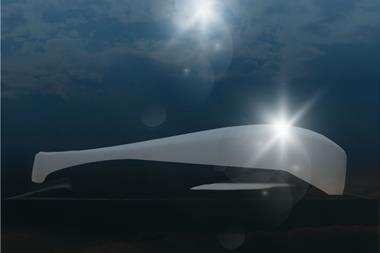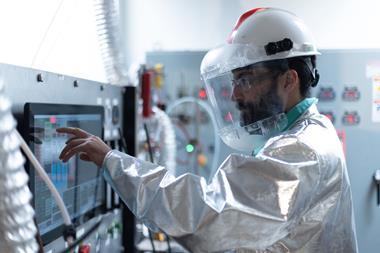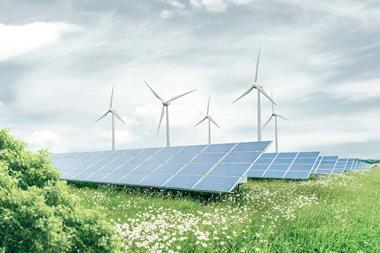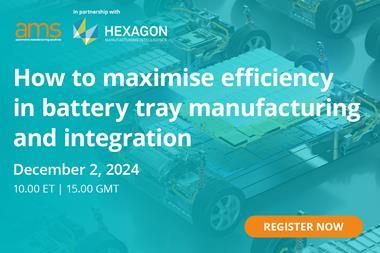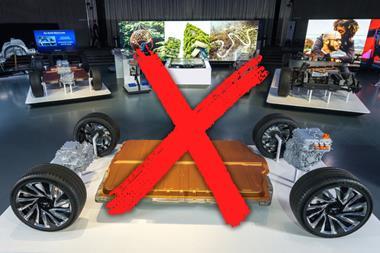
Fronius recently held its annual international conference, and this year’s topic was 'Demands of joining technology for modern vehicle makers'. The Austrian company’s close working relationship with major OEMs was apparent from the number and quality of speakers present. All those attending represented brands associated with quality production but they ranged from high volume producers to makers of exotic sports cars.
One thing they all had in common was the challenge of designing and building cars that are lighter, stronger and more efficient. The current push toward light-weighting has seen a variety of construction material options being investigated and the vehicle makers explained their reasoning behind the choices being made.
Industry experts
Also present were representatives from the steel producers, there to present their perspective. Peter Schwab of Voestalpine discussed the challenges of producing the new generation of high-strength and ultra-high strength steel suitable for use in vehicle production. Schwab explained how steel development had progressed: “We have dealt with the issues of corrosion and safety, the next big challenge is to reduce the weight of the vehicle in body-in-white. While light-weighting alone is not the total solution, it will contribute to reducing emissions.” He also pointed out the need for sustainability throughout the whole vehicle lifecycle, taking into account how much CO2 is produced during production. Schwab compared the CO2 emissions from steel production from those of aluminium, magnesium and carbon fibre, stating that steel was the lowest CO2 producer. He did add that much was dependent on the type of facility the steel was being produced in. Voestalpine have been working on producing multi-phase steels that offer high strength and but also good levels of ductility using a variety of heating and quenching processes. Schwab stressed the importance of working closely with both OEMs and Tier suppliers like Fronius to explore the best options for joining the new steels and developing new joining technologies that would enable further lightweighting of future vehicles.
Magna Steyr revealed an ambitious project to develop a new lightweight vehicle platform that would utilise a variety of 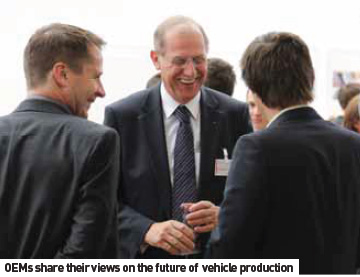 materials and construction techniques. Known as the CULT vehicle programme, project leader Wolfgang Fritz explained that the aim was to produce a platform for a small 4-seater car that would offer OEMs a viable lightweight vehicle architecture that could be transferred to their production models. The aims are very ambitious, with a target CO2 output of just 49g/km the CULT will use cutting edge material and construction technologies but scaled for mass production. Powertrain will initially be a small CNG engine using direct injection, which Magna say will offer both low emissions and a usable range. The CULT will feature a mixed material construction, a refined aero package and low rolling resistance. The challenge will be creating a stable, lightweight platform and a cost effective means of mass production.
materials and construction techniques. Known as the CULT vehicle programme, project leader Wolfgang Fritz explained that the aim was to produce a platform for a small 4-seater car that would offer OEMs a viable lightweight vehicle architecture that could be transferred to their production models. The aims are very ambitious, with a target CO2 output of just 49g/km the CULT will use cutting edge material and construction technologies but scaled for mass production. Powertrain will initially be a small CNG engine using direct injection, which Magna say will offer both low emissions and a usable range. The CULT will feature a mixed material construction, a refined aero package and low rolling resistance. The challenge will be creating a stable, lightweight platform and a cost effective means of mass production.
Complex casings
At first glance sheet metal battery casings for hybrid and electric vehicles might not seem that complicated, but as Frank Blome of Deutsche ACCUmotive explained they have to meet strict criteria in their construction. The battery cases are of a complex sheet metal construction that uses a mixture of welding and fasteners in the assembly. The cases need to be crash, corrosion and leak resistant but also allow access for maintenance and removal. As such they often use screw fasteners. Welded parts, such as inverter and switch cabinets are joined using an ultrasonic welding process, which is favoured due to low heat and no spattering. Asked about the use of composites or plastics for EV battery cases, Blome explained: “There are a number of considerations when it comes to the use of these materials for this application, not least of which is cost. OEMs want to avoid increased costs wherever possible, and this is more of a problem with lower volume components. Also there is the issue of EM suppression; the high-voltage systems need to be shielded to avoid causing interference, so plastics or composites would need additional shielding removing any weight advantage.”
Low volume approach
The differences in approach to materials and joining methods were highlighted by the presentation from Andrea Merulla from Ferrari. Offering the California model’s front end as an example, he discussed the Italian carmaker’s focus on incorporating aluminium into the vehicle’s architecture. With the aim to build a rigid, lightweight body the company uses a mixture of cast (front shock absorber tower), sheet and extruded aluminium sections (with high-strength steel in certain areas) joined using welding, bonding and riveting methods. The challenge has been to opitimise the material thickness (as thin as possible) and develop suitable production techniques to join the different types and thicknesses of material. Merulla said that Ferrari has moved to a CMT welding process to help achieve this, although he raised the concern that future ‘unweldable’ alloys would see a greater use of bonding and riveting joining methods. Seen in the context of other, high volume vehicle makers it seems Ferrari’s low output allows them the scope to produce more complex architectures in terms of materials and production methods.
Global production processes
For the high volume car makers, with production facilities around the world, the challenges of using new materials and joining techniques are further complicated by the need to have a process that can duplicated at any production plant, anywhere in the world as many OEMs are now building vehicles based on a ‘global platform’. Dr Günter Klawitter explained how Volkswagen are developing press hardening technologies using a process of heating the sheet steel to 900°C before putting it into the press at around 700°C. The company has adopted laser cutting techniques to avoid cracking the hardened pressed panels and uses simulations to assess the processes. Dr Klawitter also described how they have adjusted the strength of certain structural parts (such as B-pillars) by varying the thickness of the steel at different points, however, he noted that this makes the production process more complicated. VW’s efforts have proved effective with the new Golf 7 being 100kg lighter than the previous model; this has been achieved through the use of highstrength and ultra-high strength steel in BIW.
Delta spot welding
Tesla has adopted an aluminium construction for its electric vehicles featuring sheet, cast and extruded sections. The company uses CMT welding, Delta spot welding, riveting and bonding joining methods in BIW to achieve a lightweight shell. Tesla’s Dag Reckhorn explained that being able to design the vehicle from scratch meant there were fewer compromises. Audi has been a great exponent of aluminum car construction and is introducing aluminium into a greater number of models in its range, and developing welding techniques for higher production output. Delta spot welding is a process the company has been developing with Fronius for the Audi TT model. While resistance spot welding is the predominant method in steel vehicle construction it has been less effective for aluminium bodies. Audi’s Delta spot welding project leader, Andrea Kreuzwieser, discussed the need to develop a viable spot welding process for high volume aluminium vehicle production. The Delta spot welding uses a weld ‘tape’ over the electrodes that allows 3,000 spot welds to be performed before the electrode caps need attention.
Daimler’s Philip Betz delivered a presentation on the company’s production developments for an aluminium subframe assembly, which had originally been produced in one cell, and checked and finished manually. It is now produced on an automated line, greatly reducing the cycle times. The process, developed using digital simulations, has co-operative robot systems (handling and welding) assemble the subframe in various stages along the line, with the component being very accurately positioned for seam welding and inspection. Daimler uses a hybrid laser welding system, developed by Fronius. Betz pointed out that aluminium parts often require more reworking than those produced in steel. To maintain the cycle time the completed subframes are checked in a test cell and a robot welder carries out any re-working.
Quality control
Joining technology has been an important focus for BMW. Florian Oefele discussed the company’s development (with Bosch) of an online welding quality control system, which closely monitors spot weld quality. The company also uses laser welding for certain applications where the appearance as well as strength is important. To monitor the laser weld quality in production BMW has fitted a camera and laserlight to the head of the robot and developed an algorithm to determine the quality and strength of the weld. Oefele commented that innovations in the welding process were important to the whole light-weighting process. The conference concluded with a panel discussion from all the OEM representatives. They all agreed that lightweighting was key to reducing vehicle emissions but differed on material choices for mass production. It’s clear is that developments in joining technologies are pivotal to the direction of future vehicle construction





























